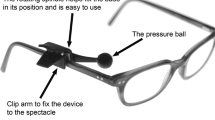Abstract
Blepharospasm is a chronic condition characterized by involuntary spasmodic closure of the eyelid(s). The present investigation empirically evaluated the relative efficacies of a current pharmacological and a psychological approach in the treatment of blepharospasm. An A-B-A-C-A single-case design was used to compare trihexyphenidyl [Artane] with EMG biofeedback. EMG activity in the frontalis muscle and number of eyeblinks were the dependent variables. The results indicated that Artane had no effect on either dependent measure and that biofeedback had a dramatic treatment effect on both dependent variables. Treatment gains were maintained at a 42-week follow-up. These results are discussed in light of the methodological considerations, the efficacy of psychological intervention, and the need for future research.
Similar content being viewed by others
References
Ballard, P., Doerr, H., & Varni, J. (1972). Arrest of a disabling eye disorder using biofeedback.Psychophysiology, 9 271.
Casey, D. E. (1980). Pharmacology of blepharospasm-oromandibular dystonia syndrome.Neurology, 30 690–695.
Daube, J. R., Kelly, J. J., & Martin, R. A. (1979). Facial myokymia with polyradiculopathy.Neurology, 29 622–669.
Frueh, B. R., Callahan, A., Dortzback, R. K., Wilkins, R. B., Beale, H. L., Reitman, H. S., & Watson, F. R. (1976). A profile of patients with intractable blepharospasm.Transactions of the American Academy of Opthalmology and Otolaryngology, 81 OP591-OP594.
Gillum, W. N., & Anderson, R. L. (1981). Blepharospasm surgery.Archives of Ophthalmology, 99 1056–1062.
Granacher, R. P. (1981). Differential diagnosis of tardive dyskinesia: An overview.American Journal of Psychiatry, 138 1288–1297.
Haider, A., & Clancy, J. (1973). Case report of successful treatment of a reflex trigeminal nerve blepharospasm by behavior modification.American Journal of Ophthalmology, 75 148–149.
Henderson, J. W. (1956). Essential blepharospasm.Transactions of the American Ophthalmologic Society, 54 453–520.
Jankovic, J. (1982). Treatment of hyperkinetic movement disorders with tetrabenazine: A double-blind crossover study.Annals of Neurology, 11 41–47.
Jankovic, J., & Ford, J. (1983). Blepharospasm and orofacial-cervical dystonia: Clinical and pharmacological findings in 100 patients.Annals of Neurology, 13 392–411.
Jankovic, J., Havins, W. E., & Wilkins, R. B. (1982). Blinking and blepharospasm.Journal of the American Medical Association, 248 3160–3164.
Marsden, C. D. (1976). Blepharospasm-oromandibular dystonia syndrome.Journal of Neurology, Neurosurgery and Psychiatry, 390 1204–1209.
Meige, H. (1910). Les convulsions de la face, une forme clinique de convulsion faciale, bilatérale et médiane.Revue Neurologique, 10 437–443.
Merikangas, J. R., & Reynolds, C. F. (1979). Blepharospasm: Successful treatment with clonazepam.Annals of Neurology, 5 401–402.
Metz, L. N., & Magee, K. R. (1960). Postencephalitic blepharospasm.Archives of Ophthalmology, 63 692–697.
Murphy, J. K., & Fuller, A. K. (1984). Hypnosis and biofeedback as adjuntive therapy in blepharospasm.American Journal of Clinical Hypnosis, 27 31–37.
Peck, D. F. (1977). The use of EMG feedback in the treatment of a severe case of belpharospasm.Biofeedback and Self-Regulation, 2 273–277.
Reckless, J. B. (1972). Hysterical blepharospasm treated by psychotherapy and conditioning procedures in a group setting.Psychosomatics, 13 263–264.
Reynolds, D. H., Smith, J. L., & Walsh, T. H. (1967). Differential section of the facial nerve for blepharospasm.Transactions of the American Academy of Opthalmology and Otolaryngology, 71 656–664.
Rowan, G. E., & Sedlacek, K. (1981). Biofeedback in the treatment of blepharospasm: A case study.American Journal of Psychiatry, 138 1487–1489.
Roxanas, M. R., Thomas, M. R., & Rapp, M. S. (1978). Biofeedback treatment of blepharospasm with spasmodic torticollis.Canadian Medical Association Journal, 119 48–49.
Shapiro, E., & Shapiro, A. K. (1981). Tic disorders.Journal of the American Medical Association, 245 1583–1585.
Sharpe, R. (1974). Behaviour therapy in a case of blepharospasm.British Journal of Psychiatry, 124 603–604.
Stephenson, N. L. (1976). Successful treatment of blepharospasm with relaxation training and biofeedback.Biofeedback and Self-Regulation, 1 331.
Tolosa, E. S. (1981). Clinical features of Meige's disease (idiopathic orofacial dystonia): A report of 17 cases.Archives of Neurology, 38 147–151.
Tolosa, E. S., & Klawans, H. L. (1979). Meige's disease: A clinical form of a facial convulsion, bilateral and medial.Archives of Neurology, 36 635–637.
Wickramasekera, I. (1974). Hypnosis and broad-spectrum behavior therapy for blepharospasm: A case study.International Journal of Clinical and Experimental Hypnosis, 22 201–209.
Author information
Authors and Affiliations
Rights and permissions
About this article
Cite this article
Brantley, P.J., Carnrike, C.L.M., Faulstich, M.E. et al. Blepharospasm: A case study comparison of trihexyphenidyl (Artane) versus EMG biofeedback. Biofeedback and Self-Regulation 10, 173–180 (1985). https://doi.org/10.1007/BF01000752
Received:
Issue Date:
DOI: https://doi.org/10.1007/BF01000752




